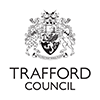Life expectancy
Life expectancy is the average number of years a person would expect to live given current mortality rates.
Average life expectancy in Trafford
The average life expectancy at birth in Trafford during 2014-16 was 83.7 years for females and 80 years for males. Average life expectancy in Trafford was slightly above England which was 83.1 years for females and 79.5 years for males.
Figure 1 shows average life expectancy at birth by all of the 324 local authorities in England. Trafford is in the 3rd quintile for average life expectancy by birth for females and males.
Average life expectancy by ward
Reporting average life expectancy at a local authority level masks considerable variation at a ward level. Figure 2 reveals that females living in Hale Barns are on average expected to reach the age of 86.9 years but those living in Bucklow-St. Martins are only expected to reach the age of 78.9 years. In fact, female life expectancy in Bucklow-St. Martins is below the Trafford average for males which was 79.8 years in 2011-15. The average life expectancy at birth for males living in Bucklow-St. Martins is 8 years lower than those living in Hale Barns.
Healthy life expectancy by ward
Healthy life expectancy is an estimate of the number of years a person is expected to live in 'good' health. If Trafford experienced the same self-reported health and mortality rates that were observed during 2014-16, females can expect to live 66.2 years in good health (79.1% of their life) and males 62.7 years in 'Good' health (78.4% of their life). This suggests that on average women can expect 17.5 years of living in 'Not good' health and men 17.3 years.
Data from 2009-13 suggests that there is significant ward variation in the number of years people can be expected to spend in 'good' health. For example, females living in Hale Central can expect to spend 73.9 years in 'good' health whilst those living in Clifford can only expect 55.7 years. This represents a high level of inequality in health life expectancy of 18.2 years.
The Slope Index of Inequality
The Slope Index of Inequality (SII) shows how much life expectancy varies with deprivation. The steepness of the slope represents the inequality in life expectancy that is related to deprivation in the neighbourhood. A horizontal line would indicate that there was no inequality.
In figure 4 the slope indicates that life expectancy increases for both females and males as levels of deprivation decreases. In 2013-15 females had an SII of 7.6 years and males 9.1 years. This gap widened during 2014-16 with life expectancy in the most deprived neighbourhoods of Trafford being 8.2 years lower for females and 10.4 years lower for males than in the least deprived neighbourhoods.
Inequality in healthy life expectancy at birth during 2009-13 was 15.8 years for females and 16.1 years for males.
Figure 5 shows the life expectancy gap for the periods 2010-12 to 2014-16. The female life expectancy gap has been steadily increasing whilst the male gap has remained largely static.
